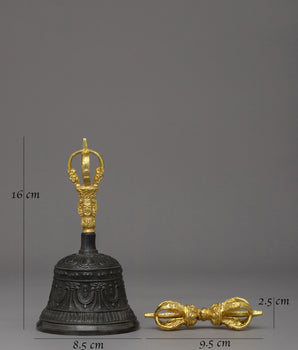









Two-Arm Lokeshwor Statue | Symbol of Compassion and Mercy

100% AUTHENTIC

HANDMADE

FREE SHIPPING
Discover the Essence of the Two-Arm Lokeshwor
------------------------------------------------------------
Size: 3.5”/9cm (Height) x 2.2”/5.5cm (Base)
Weight: 0.236 kg
Material: 24K Gold Gilded, Antique Finished, Copper Body
------------------------------------------------------------
About our Statue:
The Two-Arm Lokeshwor Statue, measuring 3.5 inches in height and 2.2 inches at the base, invites you to set off on a compassionate and benevolent path. The work of art, which is made entirely of copper and has thin layers of 24K gold gilding all over it, radiates a spirit of spiritual grace and ageless compassion. The statue's heavenly presence is enhanced by the antique finish, which offers a hint of rustic appeal.
The carefully crafted Two-Arm Chenrezig Statue is a representation of kindness and generosity. The figurine's delicate features and nuanced design encourage introspection and contemplation, leading practitioners to a more profound comprehension of compassion.
Many Buddhist traditions honor Lokeshvara, also known as Avalokiteshvara, as the embodiment of compassion. In scripture and art, he is frequently shown as a kind person who has decided to delay becoming a Buddha until he has assisted all sentient beings in achieving freedom from suffering. His name means "The Lord Who Looks Down in Compassion," which embodies his steadfast commitment to helping people. This statue of Lokeshvara's two-armed form highlights the accessibility and simplicity of his loving deeds, encouraging us to incorporate compassion and kindness into every area of our life.
Introduction To Indra:
Indra is a well-known figure in ancient Indian mythology, particularly Hinduism, as the king of the gods and controller of the sky. Indra, often pictured with a thunderbolt known as Vajra, is revered as the deity of rain, storms, and war, responsible for maintaining cosmic order and defending humanity from harmful forces. Indra is revered as a great warrior and leader of the celestial beings, the Devas. His stories are widely featured in the Vedas and epics, such as the Mahabharata and the Ramayana, symbolizing strength, courage, and the vital powers of nature essential for life and prosperity.
How do you take care of your statues?
• Place them at room temperature, avoiding direct sunlight.
• Make sure that the area where your statue is placed is entirely free of moisture and dust.
• Place it at the highest place on your altar after being consecrated by a Lama/monks. The best practice is to keep them covered inside a
glass cabinet.
• Do not use your bare hands or any objects with a rough surface to wipe the face. Directly touching the face with the bare hand can
smudge the face, leaving scratches
-----------------------------------------------------------------




















